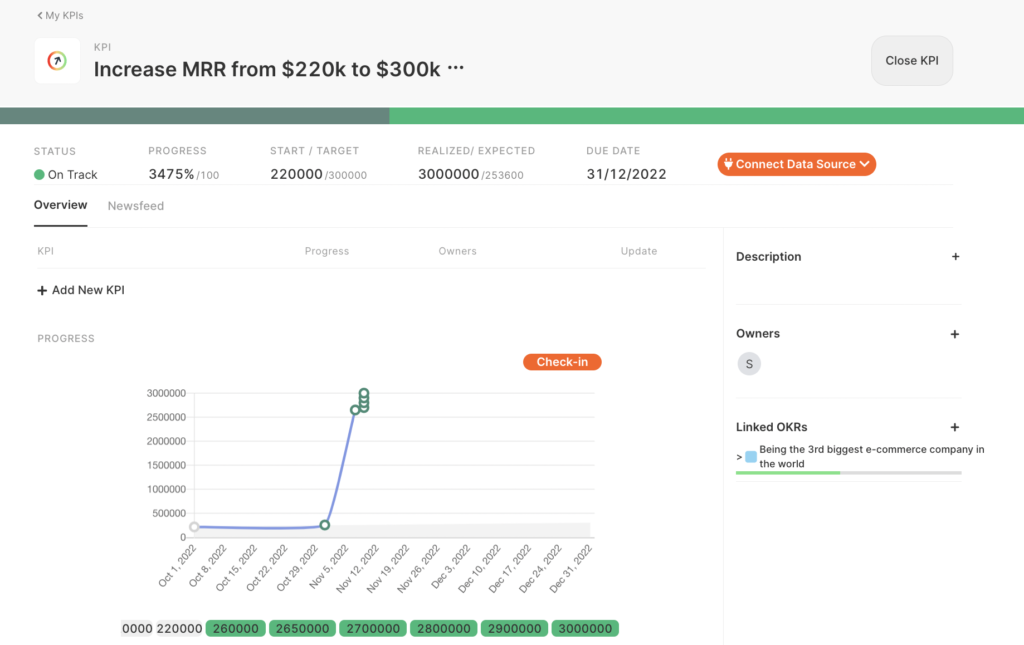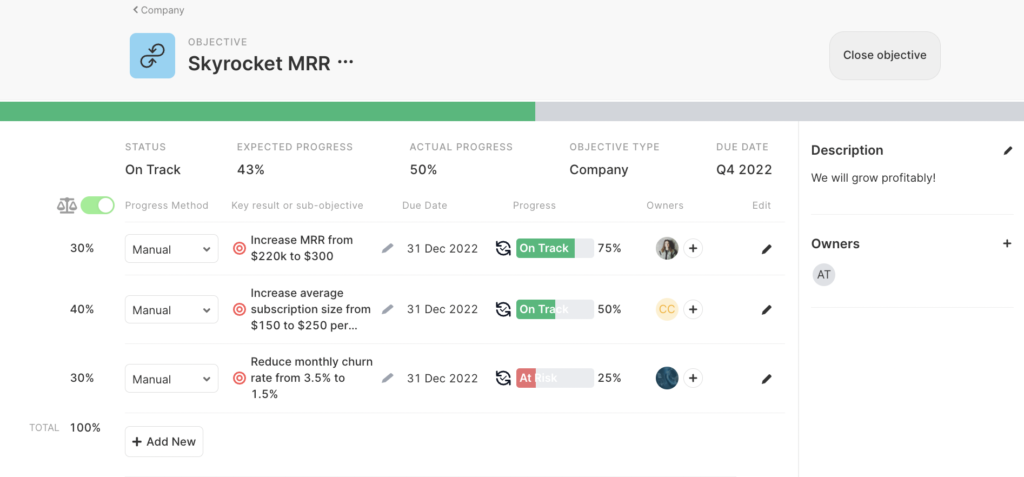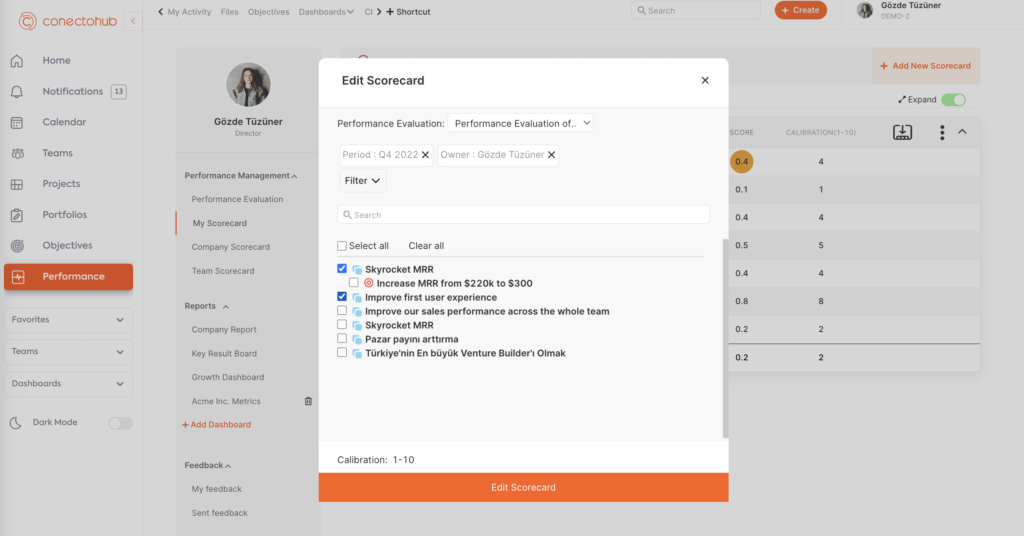
Getting right things done is vital for fast growing companies. OKRs can help you lead by showing you what you want to accomplish and how you’re going to get there. Change-oriented goals (Objectives) are paired with measures (KRs), which helps you track progress and see how you’re doing.
OKR is a method of agile goal management that is becoming increasingly popular, while traditional performance management is receiving more and more backlash. KPIs are standalone numbers (metrics) that don’t show you how you’re progressing towards your goals. All concepts revolve around increasing the organization’s performance, but there are some key differences between them.
This article aims to answer the questions:
I. What is a KPI?
II. What is an OKR?
III. What is performance management?
IV. Is OKR a performance management tool?
V. What is the difference between performance management and OKRs? Are OKR and performance management compatible? How can we use OKRs and KPIs in performance management system?
What is a KPI?
A key performance indicator (KPI) is a metric that measures how well a company is achieving its key objectives. KPIs provide a way for stakeholders to see whether the company is making progress towards its goals.
What is an OKR?
The goal of OKRs is to have a goal-setting process that is focused on improving and involves more people in strategic conversations. This will allow all teams to be more connected to the bigger picture and constantly thinking about their role in moving the company forward. This type of thinking requires more imaginative risk-taking, more improvement-focused discussions, and definitely more cross-functional collaboration.
OKRs vs. KPIs with an example
It can be helpful to have an example to follow when setting goals. The two goal-setting frameworks below can be used in a similar scenario.
Imagine running a sales team that has started to see lower monthly recurring revenue (MRR) than expected. As you want to increase MRR, you need to set adequate goals for your sales team to increase MRR.
I. In the first scenario, you choose to increase MRR by setting the following KPI:

By the end of the quarter, you can reach your KPI. However, you don’t know if you are operating profitably or your teams are focusing on the right customer base.
II. Let’s apply the OKR approach to the same situation. In this scenario, you tackle the revenue problem using an OKR. The OKR would look something like this:
With OKRs, you can see that you’re not only addressing the symptom but also the root cause. This is because you’re focusing on the key results that matter most. By doing this, you can see a decrease in churn, an increase in contract value, and an increase in MRR now you will grow profitably and sustainably

The OKR example shows how each key result contributes to the overall objective. This allows individuals to understand their impact on the final goal. This doesn’t mean that KPIs are useless. Using OKR for improvement, change, and innovation, as well as using KPIs for business as usual, is the best formula for fast-growing companies. The who, what, and how of a project are defined by its OKRs, which reveal what contributed to its success. When combined with KPIs, OKRs can provide a complete picture of your performance. They can also help identify areas requiring additional resources by warning you about lagging results
Find out more in our article Difference Between OKRs and KPIs
New to OKRs? **Start with the OKR fun course**
Need more OKR examples for your business? Reach more OKR Examples
What is performance management?
Performance management is a system that helps ensure that employees’ actions align with organizational goals. The performance management cycle has four steps: planning, monitoring, reviewing, and rewarding performance.
A performance review is an opportunity for an employer to sit down with an employee and discuss how they are doing in their current role. The focus is on the employee and their ability to meet the requirements of the job, as well as their career aspirations. The manager will provide feedback and coaching to help the employee improve their performance and develop their career. If an employee is not meeting the requirements of the job, the employer will discuss a plan for the future, which may include termination.
What is the difference between performance management and OKRs? Are OKR and performance management compatible?
I. OKRs are business-centric, meaning that they focus on what the business needs to do in order to improve. This could be in terms of customer satisfaction, revenue, product quality, or any other metric. On the other hand, performance reviews focus on the individual employee and how they can improve their skills to match their job requirements.
II. OKRs are a goal management framework that can be used by teams to measure and track progress. On the other hand, performance management is an assessment process that is typically overseen by Human Resources or another hierarchical entity.
III. When you combine OKRs and rewards, employees are less likely to help their team members and more likely to focus on their own performance. This forgoes a fundamental aspect of OKRs: their cooperative nature. Additionally, as only 60-80% of key results are meant to be accomplished, mixing OKRs with compensation makes employees prioritize rewards over creating ambitious goals. This results in lazy OKRs and a lack of innovation.
IV. OKRs are never supposed to be linked with rewards. OKRs can guide teams and organizations towards aspirational goals, while performance management assesses individuals’ abilities to perform tasks and generate desired outputs. While acknowledging the differences between the two frameworks is essential, aligning OKRs and performance management can streamline organizational success.
While you shouldn’t make OKRs and performance reviews completely dependent on each other, you can use OKRs to see how employees contribute to goals and outcomes. This can help you assess how employees contribute to activities that impact your organization’s OKRs. You can use OKRs and performance reviews together during quarterly retrospectives, where you review employees’ performance and you can use some OKRs & KPIs but we do not recommend using all of them.

The key to scale is being able to collect, view and analyze all the relevant data in one place. Without both sides being represented, it’s impossible to really understand how the KPIs balance out. ConectoHub has made it a priority to build a solution that supports fast growing companies in being able to manage their strategy and daily execution from one platform and see every detail of their company instantly.
